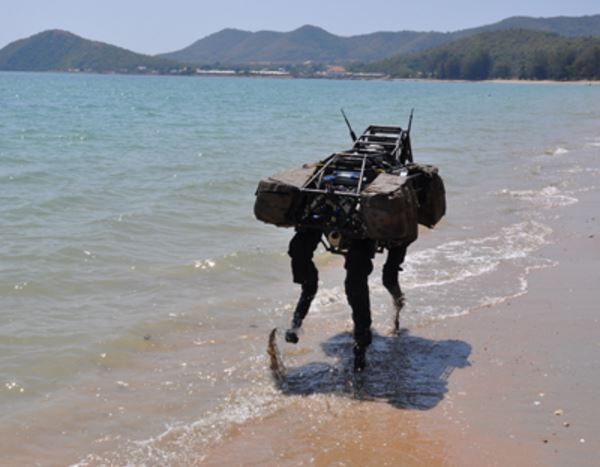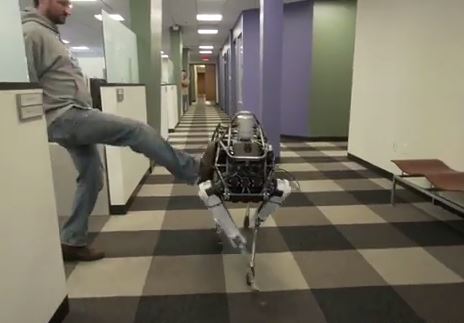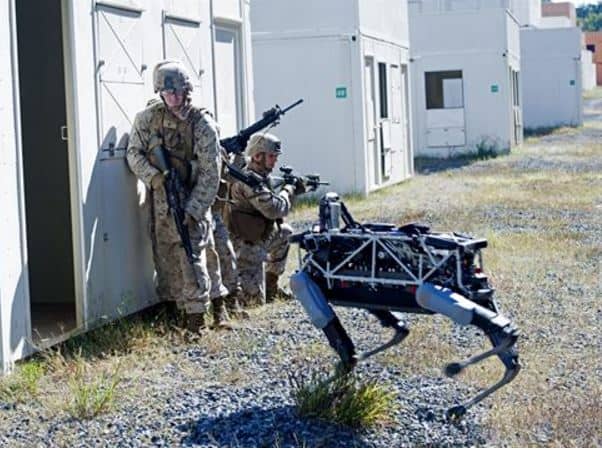The Google-owned Boston Dynamics’ robot called BigDog, that the US military had intended to deploy, is too noisy. The smaller version – Spot – was no good either. US military personnel said both robot projects have been suspended. In war situations, a machine buzzing loudly like a petrol-driven lawnmower would give away the soldiers’ location.
BigDog, known officially as the Legged Squad Support System, can carry loads of 400 pounds (181 kgs) over rugged terrain. The aim was to use it as a hi-tech beast of burden, like a mule, which historically were used by armies to transport supplies. A mule (the animal) can be packed with ‘dead weight’ of up to 20% of its body weight, or about 198 pounds (90 kg).
 BigDog can manage most terrains and can carry a fairly heavy load. It’s a pity it sounds like a lawnmower. (Image: Boston Dynamics)
BigDog can manage most terrains and can carry a fairly heavy load. It’s a pity it sounds like a lawnmower. (Image: Boston Dynamics)
“BigDog is a rough-terrain robot that walks, runs (at 4 mph), climbs and carries heavy loads. BigDog is powered by an engine that drives a hydraulic actuation system. BigDog has four legs that are articulated like an animal’s, with compliant elements to absorb shock and recycle energy from one step to the next.”
“BigDog is the size of a large dog or small mule; about 3 feet long, 2.5 feet tall and weighs 240 lbs.”
What is a robot?
The robot has been under development for five years and was initially funded by the Defense Advanced Projects Agency (DARPA). More than $42 million have been spent on its development.
A super robot – but just too noisy
However, the US Marines found BigDog’s petrol-powered engines far to noise for use in battle. A less noisy alternative that was subsequently created – Spot – was quieter but much more limited in its capabilities.
Kyle Olson, a spokesman for the US Marines’ Warfighting Lab, told Military.com:
“As Marines were using (BigDog), there was the challenge of seeing the potential possibility because of the limitations of the robot itself. They took it as it was: a loud robot that’s going to give away their position.”
 Spot was completely unfazed when one of the engineers kicked it.
Spot was completely unfazed when one of the engineers kicked it.
Perhaps BigDog should have been called BigMule – it looks more like a mule than man’s best friend.
The four-legged robot can walk, run and climb 35-degree slopes. Its computer system allows it to respond to commands while walking on different terrains, including snow, mud and water.
John Vandiver, writing in Stars and Stripes, explained that light infantrymen move in tight formations and often require the element of surprise. Having a loud, buzzing petrol-powered robot “was like a huge metallic bull’s eye.”
 Spot helping Marines clear a room during a demonstration at Marine Corps Base Quantico, Va., Sept. 16, 2015. (Image: media.defense.gov)
Spot helping Marines clear a room during a demonstration at Marine Corps Base Quantico, Va., Sept. 16, 2015. (Image: media.defense.gov)
Spot – the electrically powered alternative
Boston Dynamic developed Spot, an electrically-powered alternative to BigDog. It is smaller, much nimbler and a great deal quieter. Boston Dynamics says Spot never seems to fall down. It can run, walk, climb awkward hills with ease, and even goes up steps with smooth elegance.
However, Capt. James Pineiro, the branch head for Marine Corps Warfighting Lab, told military.com that Spot, being controller driven, lacked the autonomy required to work as a “ground reconnaissance asset.”
Spot can only carry 40 pounds (18 kg), which significantly limits its uses.
The US military says it plans no future trials with either BigDog or Spot, i.e. the whole thing has been shelved.
Marines shifted from keen to cool
Not long ago, in September 2015, the Marine Corps Warfighting Lab was super excited about Spot. In the official Marines website, in an article titled “Four-Legged Robot Runs Toward Potential Future with Marine Infantry”, Capt. James Pineiro said:
“We want to continue to experiment with quadruped technology and find ways that this can be employed to enhance the Marine Corps warfighting capabilities.”
“The Marines have been very receptive to the new technology, embrace it and come up with new ideas we couldn’t even dream up.”
